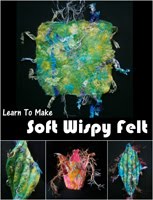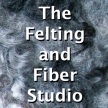I was tidying away some felt recently and remembered that I'd planned to make some felt pieces like the
textured nuno pieces I made, but with different fibres instead of fabric. I've tried 'piling on' embellishment fibres in the hope of getting a fluffy effect or loosely attached/3D look a few times, but apart from a really slippy/slinky feeling acrylic fibre, and some weird fibre/wool combos (Suffolk wool and banana fibre springs to mind) they've all just stayed put and attached well. Since I mostly use Merino for 'everyday' pieces, I wanted to see how a couple of layers of different fibres attached, and also what effect I'd get from some hard fulling.
I laid out a couple of pieces the same way, but different sizes. I laid out two layers of dyed viscose fibre, then 4 fine layers of 23 mic Merino. I felted and fulled the first piece, then got my bead board out to full it more. I fulled until it was quite firm, but not stiff/rigid:
I got the texture I expected:
I didn't expect so much migration, probably because the soft/fine pieces I've fulled really hard with fibres before were using white 18.5mic Merino, and I used less fibre, I thought it'd be less obvious this time:
I changed my plans when I got to the felted stage of the first piece, it looked and felt so nice. So, I decided I would just felt the next piece 'normally'. Even if I hadn't already decided that, I don't think I could have 'ruined' this piece by fulling it lots:
The colours and the sheen are just gorgeous, so is the softness and drap, even though it's only a small sample:
Those ridges/crinkles are because I squeezed it in a towel, then hung on the line to dry! If you look at the blue parts you might see a crease along the edge too, it's such a light piece, the pegs weighed it down and bent it. Here's a close up:
You can see the differences in sheen and texture when the pieces are next to each other:
This is the soft piece on the template I used, it started out just a bit bigger than the small box it's on top of:
And the small piece started out the size of the largest outline on the template:
And yep, those are the same template!
I made a few more fibre samples. I thought I'd use the same template for all of them to do comparisons. In the end, I only did a 'normal' sample and a 'fulled hard' sample of Trilobal Nylon for a direct comparison. Though thinking about it, for a 'proper' comparison, I should really have used the same colours! Each sample has two layers of the fibre, and 4 thin layers of 23 mic Merino. This is the Trilobal Nylon sample which I felted and fulled in the way I usually do:
Here's a close up of the ripples/texture:
This is the Trilobal nylon sample I made and fulled hard:
The texture was interesting, especially where I used different colours for each fibre layer:
This next one is Soy top which I dyed, the tops all look nice, shiny, metallic shades, but for some reason, they now look a bit like wet tissue. Maybe two layers dulls the sheen?
The silver end looked quite nice:
My favourite piece out of these was the Nylon Staple sample. It had a really nice, thick texture:
You can see it a bit more on an angle:
At first I was a bit disappointed with all the migration, because it covered some areas:
But, then I noticed there was something quite regular, almost geometric about the migration:
It can always be disguised by using a matching colour, or made a feature of by using a complementary colour. Here is a photo of the nylon and soy pieces next to each other:
And, for reference, the bigger Trilobal Nylon sample on the template I used:
So, you can see, you don't need to cautiously anchor down a few strands of fibre with wisps of wool! I used quite a lot of fibre on each sample. The nylon staple is one which intrigues me the most because I love texture and it has me thinking of ways to use it, but the Viscose top is gorgeous, so vibrant and shiny!
If you're curious about using embellishment fibres in wet felting, but don't know where to start, have a look at the info page for my e-book, The Right Fibre: https://feltbyzed.blogspot.co.uk/p/the-right-fibre.html

































































